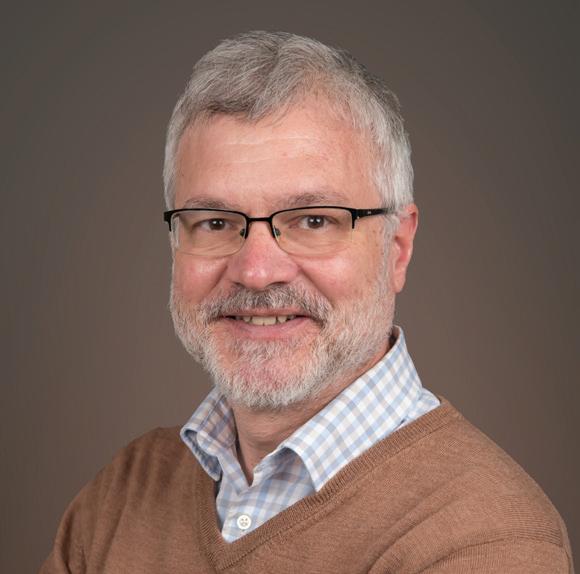
5 minute read
Magnetic Moments David Cahill’s work with antiferromagnets
Magnetic Moments
At Illinois, materials scientists are investigating a select group of magnetic materials that could lead to innovations in data storage, mechanical engineering, and more.
Advertisement

DavidCahill,GraingerDistinguishedChair
WRITTEN BY DANIEL LE RAY
Understanding the atomic properties of a subset of magnetic materials may be the key to more efficient digital information storage, according to David Cahill, a Grainger Distinguished Chair of Engineering and Team Leader in the Illinois Materials Research Science and Engineering Center (I-MRSEC).
Founded in 2017, I-MRSEC’s goals are twofold: to advance the fundamental science of materials with an eye toward applications; and to provide students, the community, and historically underrepresented groups with access to cutting- edge research. Cahill leads one of I-MRSEC’s two interdisciplinary research groups, IRG1, which focuses on a group of materials known as antiferromagnets.
“We’ve taken on this little piece of the materials world— materials that are metallic and have antiferromagnetic order,” said Cahill.
Antiferromagnets are not like the magnets we stick to our fridge doors or study in high school science class.
These are ferromagnets, which “have underlying magnetic moments associated with each atom, and if you add them all up, they have a net direction,” explained Cahill. This magnetic direction is useful for things like making motors, transformers, or magnetic storage devices.
Antiferromagnets, on the other hand, consist of atoms with magnetic moments that are ordered in opposition to one another.
“In these kinds of systems, if you average all the atoms’ magnetic moments, then it sums to zero, so there’s no external magnetization that can be used in the conventional ways,” Cahill said. There still is an underlying direction—“it’s just very difficult to observe.”
Observing, measuring, and potentially manipulating the magnetic moments associated with the atoms in antiferromagnets is one of IRG1’s primary goals.
“It’s a new initiative, so that has its own challenges,” said Cahill, whose background is in transport properties—how materials conduct heat or current, for example. “But I think it’s also quite exciting to have something

that everybody can contribute to, and not have the legacy of some other work inhibiting this new direction.”
Cahill explained why IRG1 is targeting metallic antiferromagnets in particular. Typical ferromagnetic materials, like iron or nickel, tend to be metals and therefore conduct electricity; antiferromagnets tend to be insulators.
“Because most antiferromagnetic materials are not electrical conductors, you can’t connect leads to them and currents don’t help you,” Cahill said. “But it was discovered four or five years ago that electrical currents could be used to change the order and also detect the order in these materials.”
This innovation led to a renewed interest in this class of materials. And by honing in on metallic antiferromagnets—that is, antiferromagnets that can act as electrical conductors—the group hopes that its findings may have greater potential in the worlds of technology, electrical engineering, and beyond.
Because the science behind antiferromagnets is interdisciplinary and cutting-edge, IRG1 includes seven faculty members spanning physics, engineering, and materials science. The team is interested in “both how electrical currents or light from lasers can affect the order and how electrical currents or lasers can be used to detect the order in these materials.”
Cahill elaborated on some of the science behind their work: “The interaction between electrons, phonons, and magnons is part of what we investigate to understand these fundamental mechanisms of how you can write or manipulate the magnetic order using electrical currents or light.”
Phonons are a quantized wave of how the atoms in the material are vibrating, while magnons are a quantized wave of the spinning motions that the atoms’ magnetic moments exhibit. The group’s most recent paper documents efforts to measure how much energy it takes to change the atomic order of an antiferromagnetic material’s magnetic moments— something referred to as magnetocrystalline anisotropy.
Though future applications may be years or even decades away, one area in which IRG1’s research has significant potential is digital data storage—RAM for computers and cellphones.
Cahill explained that if the magnetic moments of individual atoms in an antiferromagnetic material could be changed from opposing one another in one direction to opposing one another in a different direction, “those states, in principle, could be used to store information.”
Atoms pointing north and south could be bit zero and atoms pointing east and west could be bit one, for example. And because the magnetic moments in an antiferromagnet are not affected by external fields, computer chips made from these materials could also be made more compact and use less power.
“Those are basically all the things you want out of a memory: you want it to be dense, you want it to use low amounts of energy, and you want it to be fast,” Cahill said, adding that advancing innovation in this area is still very much at the level of basic science.
“We are working at a very fundamental level, studying the basic properties of the crystal and the magnetic order, and how it interacts with current and light. Those are the kind of fundamental, intriguing sorts of scientific principles that make these materials interesting at a bigger picture level.”
In addition to sharing his work with colleagues and students, Cahill is most excited by the interdisciplinary nature of his research group.
The faculty members working with IRG1 are an end-to-end research team, “from people who grow materials and study their structure to people who do computer models to understand how electrons and phonons and magnons behave, to people who are experimentalists studying interactions with light or how you might manipulate things with electrical currents,” he said.
“There’s a whole set of steps involved that have to come together to make advances.”










